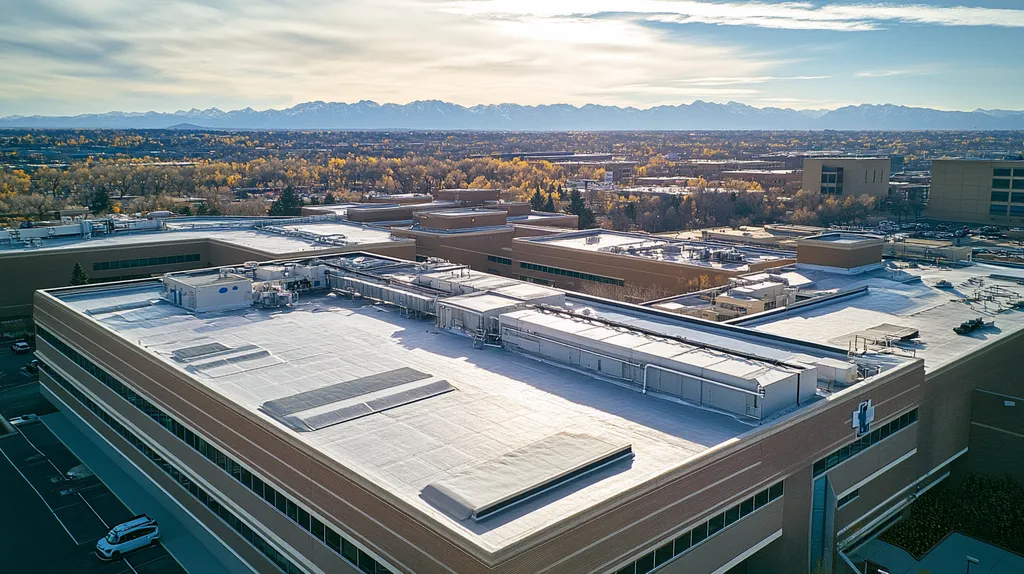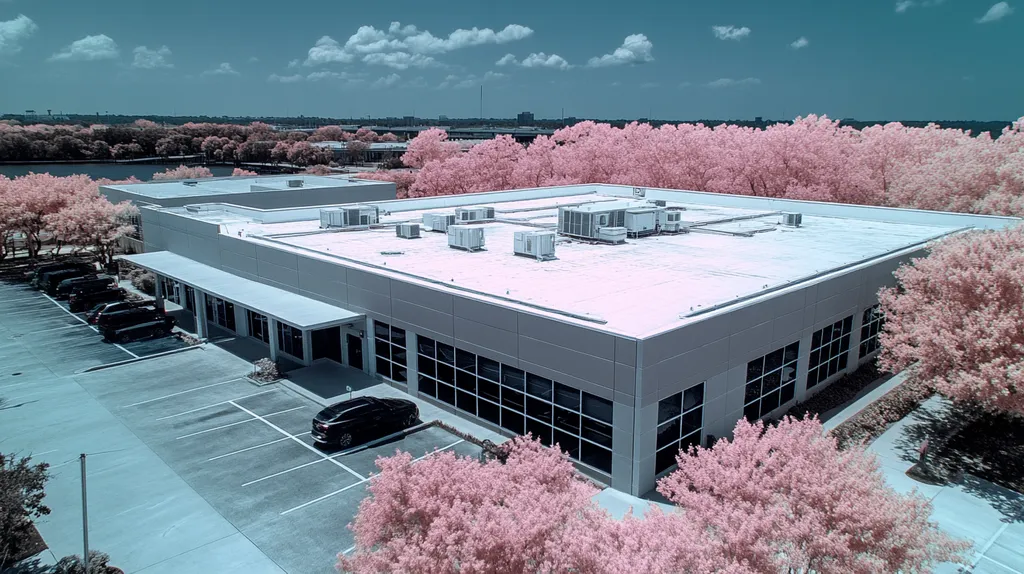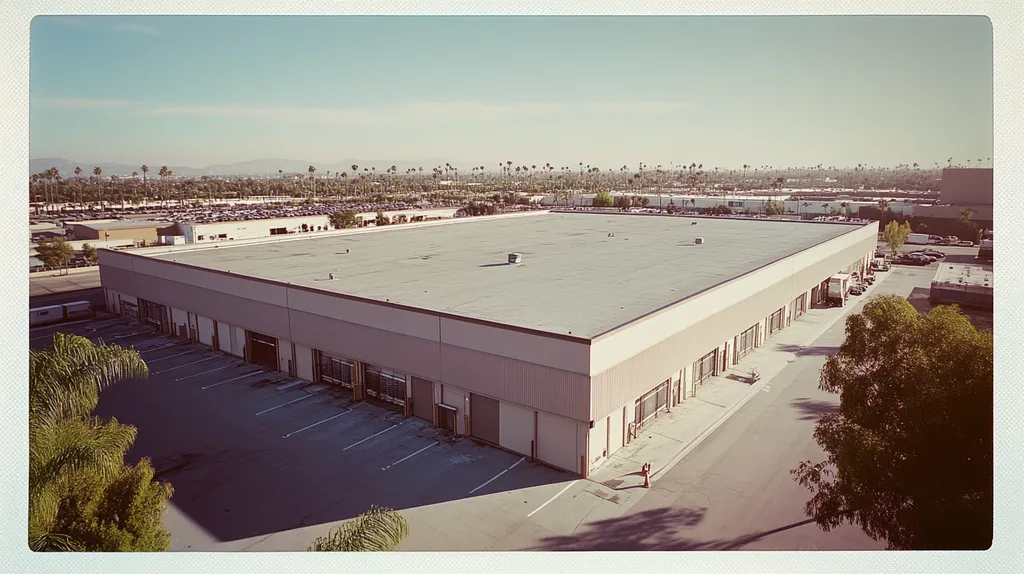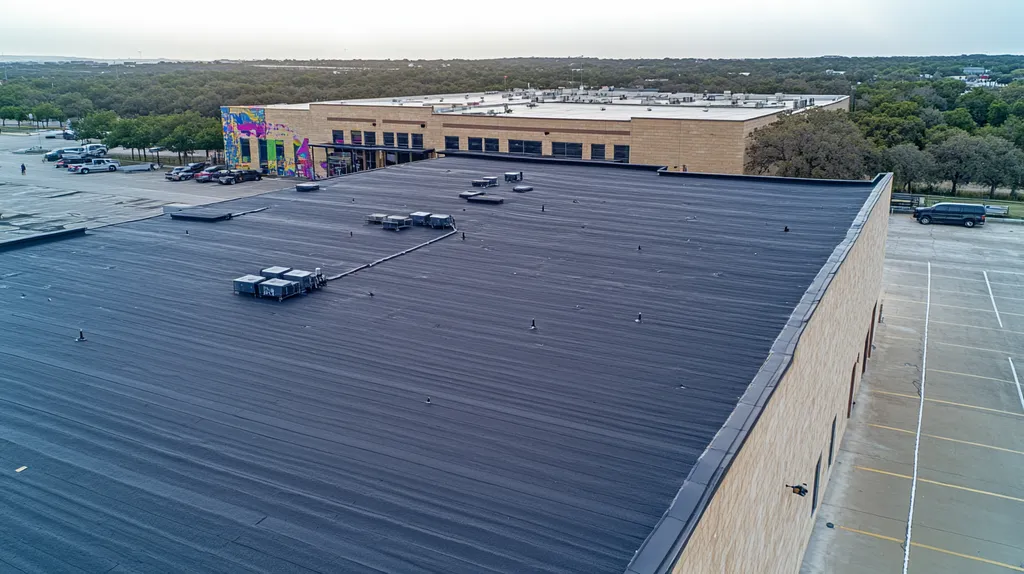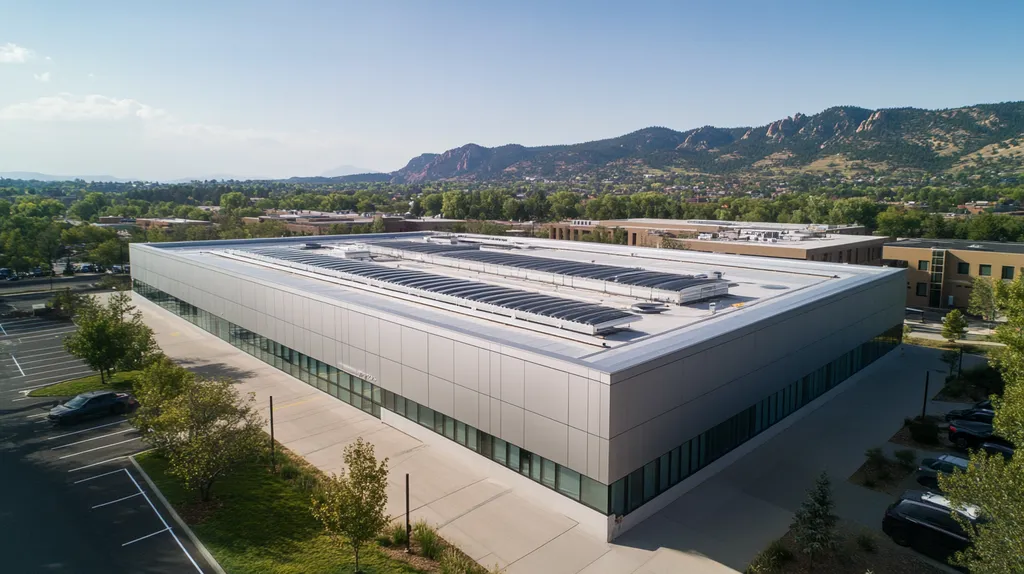In today’s commercial buildings, up to 40% of energy costs stem from inefficient lighting design – a staggering expense that impacts both operational budgets and environmental footprints.
The integration of strategic lighting solutions in commercial roof design has emerged as a critical factor in building performance, directly affecting energy consumption, workspace productivity, and property value.
For facility managers and property owners, understanding how to optimize rooftop lighting through modern design principles and technologies can unlock significant cost savings while creating more sustainable, productive environments.
SECTION 1: PERFORMANCE FACTORS
Lighting should never be an afterthought in commercial roof design. Its integration directly impacts energy efficiency and overall tenant satisfaction. Research indicates that harnessing natural light can lead to a remarkable 20% reduction in energy expenses. Property owners keen on optimizing their buildings should prioritize understanding these performance factors, as they can yield significant enhancements in operational effectiveness and tenant appeal.
Energy Efficiency Benefits
Maximizing natural light in commercial roofs is a game changer. It drastically reduces reliance on artificial lighting, leading to noteworthy energy savings—especially in large facilities. For instance, the strategic installation of skylights and light tubes can cut energy costs by up to 30% over time.
Energy-efficient roofs that incorporate modern materials help regulate heat gain and loss. By selecting reflective coatings and effective insulation, property owners can significantly improve their energy performance. This commitment not only enhances profitability but also extends the ROI from energy savings.
As sustainability efforts gain momentum, designing roofs that optimize lighting meets both green goals and market demands. This approach can attract eco-conscious tenants and even offer property owners potential tax incentives.
Key Action Items
Natural Light Distribution
The strategic installation of windows and skylights is vital for maximizing natural light distribution in commercial roofs. Buildings that successfully leverage natural light create inviting and productive environments, which is crucial in competitive real estate markets.
Natural light fosters a consistent and pleasant atmosphere. Roof designs that feature operable windows enhance ventilation and control over light intake, significantly reducing dependence on artificial lighting and boosting visual comfort.
This thoughtful design ensures even light distribution throughout workspaces, minimizing shadows and enhancing visibility. Such adjustments lead to safer, more productive environments for employees and visitors alike. Moreover, integrating natural light can elevate architectural appeal, thus attracting prospective tenants and increasing occupancy rates.
Key Action Items
Workspace Productivity
Bright, well-lit workspaces can enhance productivity by as much as 15%. Natural light, specifically, is linked to improved mood and cognitive function among employees. Investing in roofs designed to maximize light penetration can create energized environments that foster performance.
Studies show that employees in naturally illuminated spaces experience greater job satisfaction and reduced stress levels. In contrast, poorly lit areas can lead to fatigue and diminished focus, which negatively impacts operational efficiency. Therefore, strategic roofing choices can significantly enhance employee retention rates.
Additionally, aesthetically pleasing, well-lit work areas attract higher-quality tenants who are willing to invest in their office environments. This leads to increased property marketability and a vibrant workplace culture.
Key Action Items
SECTION 2: FINANCIAL CONSIDERATIONS
Financial implications are critical when it comes to commercial roofing decisions. High-performance roofing designs that prioritize lighting can lead to significant reductions in utility costs and long-term savings. Property owners need to carefully measure initial installation expenses against potential future benefits to make the best choices, ensuring they maximize budget efficiency and energy performance.
Reduced Utility Costs
Investing in smart lighting design for roofing systems can drastically cut utility costs. By using reflective materials or advanced skylights, buildings harness natural light, which reduces their dependence on electric lighting. This strategy not only trims down monthly energy expenses but also helps create a smaller carbon footprint.
Buildings that are designed to maximize natural daylight can achieve lighting energy reductions of up to 75%. This highlights the transformative potential of a thoughtfully designed roofing system on overall energy consumption. Property owners should consider investing in these lighting-enhancing solutions for worthwhile long-term financial results.
Additionally, well-lit spaces have been shown to boost tenant and employee productivity, which can lead to enhanced revenue for property owners. As high-performance roofing designs attract quality tenants and improve retention, the financial advantages become even clearer.
Key Action Items
Initial Installation Expenses
Property owners may hesitate to invest in innovative roofing designs due to concerns about high initial installation costs. While implementing advanced lighting solutions can increase upfront expenses, it is vital to consider these costs in the bigger picture. Investing in quality materials and designs leads to better durability and energy efficiency, which can ultimately save money in the long run.
Moreover, various local and federal incentives are available to help offset the initial costs of high-performance roofing systems. Sustainability programs often ease financial burdens, making investments in innovative roof designs more achievable. Leveraging these incentives can significantly lower overall expenditures.
Choosing a roof that integrates efficient lighting solutions can elevate the building’s long-term value. With energy efficiency becoming increasingly important for tenants and buyers, properties that utilize advanced roofing solutions are positioned to see a rise in market value.
Key Action Items
Long-Term Cost Savings
The financial benefits of high-performance roofing extend well beyond just lower utility bills. Incorporating innovative lighting solutions can reduce maintenance costs over the roof’s lifespan. Durable materials specifically designed to endure environmental factors can minimize the need for frequent repairs and replacements, leading to savings over time.
A well-lit environment can also enhance tenant satisfaction and occupancy rates. Happy tenants are more likely to stay longer and require fewer upgrades, positively impacting the property owner’s revenue. Investing in effective lighting strategies can create a more stable income stream.
Numerous case studies show that energy-efficient roofs can lead to energy costs decreasing while property values increase by up to 20%. This significant return on investment underscores the importance of considering long-term benefits when evaluating roofing options.
Key Action Items
SECTION 3: COMPLIANCE REQUIREMENTS
Ensuring compliance with regulations is not merely about avoiding legal penalties; it profoundly influences the efficiency and safety of lighting systems in roof design. Non-compliance can lead to inflated energy costs, jeopardized safety, and damage to a property’s reputation. Property owners and facility managers must stay informed and adept in navigating the intricacies of environmental regulations, safety standards, and building codes to achieve optimal performance and sustainability.
Environmental Regulations
Grasping the complexities of environmental regulations is essential for commercial roofing projects. Both local and federal guidelines set restrictions on permissible light pollution and manage emission levels from roofing materials, as established by the EPA.
Non-adherence to these regulations can incur significant penalties and obstruct efforts towards sustainability, negatively affecting corporate image and relationships with the community. Choosing energy-efficient materials not only meets these regulatory standards but can also enhance a building’s visual appeal.
Conducting regular audits and keeping roofing strategies up-to-date ensure compliance with evolving environmental mandates. Collaborating with environmental consultants provides valuable insights into local requirements.
Key Action Items
Safety Standards Compliance
Safety standards are integral in the design and maintenance of commercial roofs. Organizations like OSHA enforce rigorous guidelines to protect workers during installation and maintenance operations.
For instance, having proper guardrails and clear signage is crucial to mitigating fall risks. Failure to comply can result in workplace accidents and expose property owners to serious liability concerns.
Prioritizing ongoing safety training for maintenance personnel ensures that procedures reflect the latest safety standards. A safe roof is not only legally compliant but also contributes to enhanced operational performance and employee productivity.
Key Action Items
Building Code Adherence
Building codes outline the minimum standards for the structural integrity and design of roofs, making adherence vital for long-term performance and durability. Ignoring these standards can lead to legal issues and costly reconstruction efforts.
Each jurisdiction may have unique codes pertaining to roofing materials and installation techniques, necessitating proactive measures from property owners to ensure compliance. Collaboration with architects and code officials can pave the way for innovative solutions that optimize lighting while adhering to codes.
Moreover, conforming to building codes can enhance a building’s marketability, leading to higher occupancy rates and more competitive rental prices, positively influencing property value.
Key Action Items
SECTION 4: RISK MANAGEMENT
Effective risk management in commercial roof design is essential for maintaining a building’s integrity and performance over time. Weather-related damages can lead to significant financial losses and operational disruptions, costing property owners billions annually. By prioritizing material durability, maintenance needs, and liability concerns, facility managers can safeguard against unforeseen setbacks and enhance overall building performance.
Weather Resistance and Durability
Weather resistance should be a top priority in roofing design, especially in regions susceptible to extreme weather. Commercial roofs face heavy rain, snow, wind, and UV exposure, which can degrade roofing materials over time. Choosing durable materials like thermoplastic polyolefin (TPO) and modified bitumen can significantly enhance a roof’s resistance to these elements.
Applying reflective coatings helps extend the lifespan of roofs by reducing heat absorption and thermal expansion. By investing in such strategies, property owners can not only improve energy efficiency but also minimize long-term replacement costs. Regular inspections are crucial to catch signs of wear early and maintain roof integrity.
A roof that effectively withstands environmental stressors goes a long way in safeguarding a building against unexpected damages, enhancing its longevity and performance.
Key Action Items
Maintenance and Repair Needs
Regular maintenance is crucial for mitigating risks associated with commercial roofs. Neglecting routine care can allow minor issues to escalate into costly repairs. Facility managers should establish a comprehensive maintenance schedule to facilitate early detection of potential problems.
The accumulation of moisture and debris can jeopardize a roof’s lifespan, leading to serious issues like leaks or structural damage. A proactive approach to maintenance not only ensures optimal roof condition but also minimizes liability risks for property owners.
Scheduled inspections should cover crucial areas such as seals, drainage systems, and flashings. Keeping detailed records of maintenance history aids in effective future decisions and can be invaluable during insurance assessments.
Key Action Items
Liability and Insurance Implications
Understanding the liability and insurance implications of roofing is vital for property owners. A compromised roof can lead to serious accidents, increasing the potential for legal claims. It is the owner’s duty to ensure roofs are safe and functional.
Insurance providers often assess the condition of a building’s roof when determining coverage and pricing. Failure to maintain roofs can result in higher premiums or challenges in securing adequate liability coverage. Thus, preventative maintenance is essential—not just for safety, but for protecting financial interests.
Integrating high-performance roofing materials along with documented care practices can reduce claim rates while enhancing relationships with insurers. Adhering to local safety codes also minimizes legal complications, underscoring the importance of proactive risk management in roofing.
Key Action Items
SECTION 5: OPERATIONAL PROCEDURES
Operational procedures are essential in commercial roof design, especially for effective lighting integration. Inadequate lighting setups can result in energy waste, hinder visibility, and pose safety risks to both occupants and workers. It’s crucial for facility managers and property owners to establish robust operational protocols to prevent these issues and ensure that the lighting systems perform at their best. This section outlines essential installation processes, maintenance guidelines, and troubleshooting strategies for successfully managing lighting systems.
Installation Process Overview
Begin your installation process with a thorough assessment of the roof’s design and structure, pinpointing ideal fixture placement for optimal light distribution. This careful planning will help maximize natural lighting while accounting for any potential obstructions.
Choosing the correct lighting type is equally vital. Energy-efficient LED systems not only provide longevity but also meet the specific lighting needs of your facility while adhering to local regulations.
Proper installation involves secure mounting and electrical configuration, which necessitates collaboration with certified professionals to ensure compliance with safety protocols and building codes.
Engaging in a pre-handover inspection can identify any installation errors and reduce future lighting issues, enabling smooth operation once the system is activated.
Key Action Items
System Maintenance Guidelines
Maintaining lighting systems is key to extending their life span and ensuring optimal performance. Property owners should implement a routine inspection schedule, ideally every six months, to evaluate fixture integrity and light levels.
During these inspections, look for signs of damage, like cracked lenses or faulty bulbs, and promptly replace any defective components to minimize disruptions in operations.
Another important aspect is cleaning fixtures regularly; dust and debris can significantly reduce light output and efficiency. Keeping fixtures clean ensures maximum performance and energy savings.
Finally, maintaining a log of all activities facilitates troubleshooting and provides insights into the performance of the lighting system over time.
Key Action Items
Troubleshooting Common Issues
Inevitably, issues with lighting systems can arise, even with regular maintenance. Early identification and resolution of these problems can prevent operational interruptions. A frequent issue is uneven lighting, often caused by misaligned fixtures or burnt-out bulbs.
Begin troubleshooting by checking each fixture’s functionality; repositioning misaligned fixtures can ensure even light distribution. Immediate replacement of burnt-out bulbs is also essential to maintain visibility.
Electrical failures can occur as well. Flickering lights or complete shutdowns may indicate faulty circuit connections, necessitating an inspection of the electrical system and potentially an upgrade to handle capacity.
For complex issues beyond simple fixes, consulting a qualified lighting technician will ensure accurate diagnosis and efficient resolution.
Key Action Items
SECTION 5: OPERATIONAL PROCEDURES
In commercial roof design, proper lighting is crucial for both safety and aesthetic appeal. Poorly executed lighting installations can lead to wasted energy, visibility challenges, and safety hazards for occupants. Facility managers and property owners must implement robust operational procedures to prevent these expensive pitfalls and ensure lighting systems operate effectively. This section offers insights on installation, maintenance practices, and troubleshooting techniques for successful lighting integration in roofing.
Installation Process Overview
Installing lighting systems on commercial roofs requires meticulous planning and execution. Start by conducting a thorough assessment of the roof’s design and structure to identify optimal fixture placements, maximizing light distribution and accounting for potential obstructions.
Selecting the right type of lighting is also essential. Energy-efficient LED systems are ideal as they offer longevity and meet the specific lighting needs of your facility while adhering to local regulations.
Ensure that installation follows industry best practices by focusing on secure mounting and correct electrical configurations. Collaborating with certified professionals safeguards compliance with safety protocols and building codes.
Finally, conducting a pre-handover inspection helps uncover any installation issues, minimizing the chances of lighting-related complications once the system is active.
Key Action Items
System Maintenance Guidelines
Regular maintenance is key to extending the lifespan and effectiveness of lighting systems. Property owners should establish a routine inspection schedule, ideally every six months, to evaluate fixture integrity and light performance.
During these inspections, check for signs of damage, such as cracked lenses or malfunctioning bulbs, and replace any faulty components promptly to ensure ongoing operational efficiency.
Additionally, maintaining clean fixtures is often overlooked; dust and debris can significantly reduce light output. Regular cleaning is essential for optimal performance and energy conservation.
Lastly, keeping documentation of all maintenance activities can assist in troubleshooting recurring issues, providing valuable insights into the lighting system’s performance over time.
Key Action Items
Troubleshooting Common Issues
Despite a rigorous maintenance schedule, lighting issues may still occur. Early identification and resolution are vital to avoid operational interruptions. A frequent problem is uneven lighting, often caused by misaligned fixtures or burnt-out bulbs.
To troubleshoot, start with checking the functionality of each fixture; adjust misaligned fixtures to ensure even light distribution. Immediately replace burnt-out bulbs to maintain visibility.
Electrical issues are another common concern. Flickering lights or complete shutdowns may signal faulty circuit connections, requiring inspection and possible upgrades of the electrical system.
For complex problems beyond simple fixes, it is advisable to consult a qualified lighting technician. Their expertise ensures accurate diagnosis and efficient resolution.
Key Action Items
Moving Forward
With lighting costs representing up to 40% of commercial buildings’ energy expenses, implementing strategic roof lighting solutions is no longer optional – it’s a competitive necessity.
Property owners who fail to optimize their rooftop lighting design risk falling behind as high-performance buildings become the new standard, potentially facing increased operational costs and decreased property values.
The data is clear: buildings utilizing advanced lighting solutions through thoughtful roof design can reduce energy costs by up to 75% while increasing worker productivity by 15%.
As environmental regulations tighten and tenant expectations evolve, investing in efficient, well-planned lighting systems represents one of the most impactful ways to future-proof commercial properties.
The time to act is now – before rising energy costs and stricter regulations make modernization even more challenging and expensive.
FREQUENTLY ASKED QUESTIONS
Q. How can commercial roof lighting enhance energy efficiency?
A. Integrating natural light into your commercial roof can significantly lower energy costs. Properly positioned skylights and windows harness sunlight, reducing the need for artificial lighting, leading to energy savings of up to 30%. Additionally, energy-efficient roofing materials help maintain temperature, further minimizing reliance on heating and cooling systems.
Q. What are the financial benefits of an industrial roof with better lighting?
A. A well-designed industrial roof can lead to noticeable utility savings by enhancing natural lighting. Reduced electricity consumption translates to lower monthly bills, while brighter, well-lit workspaces can improve worker productivity, ultimately leading to higher revenue for property owners. Over time, these improvements significantly enhance financial returns.
Q. How do compliance requirements affect commercial roof lighting?
A. Compliance requirements ensure that commercial roofs meet safety and environmental standards. Ignoring these can lead to fines and operational issues. Understanding and adhering to local and federal regulations not only avoids penalties but can also enhance the roof’s performance and longevity while boosting its market appeal.
Q. What risks should I consider for my commercial roof?
A. Weather resistance, maintenance needs, and liability are key risks for commercial roofs. Strong storms and environmental factors can damage roofs, leading to costly repairs. Regular inspections and using durable materials help mitigate these risks, while maintaining roof safety can avoid liability issues and protect your investment.
Q. What are the key operational procedures for roof lighting?
A. Essential operational procedures include a thorough installation assessment, regular maintenance checks, and prompt troubleshooting. Properly locating fixtures and using energy-efficient designs are crucial. Regular inspections for damage and cleaning can prevent energy waste, ensuring that lighting systems function optimally and enhance the safety and ambiance of the workspace.
Q. How can I improve tenant satisfaction with my commercial roof?
A. Enhancing natural light on your commercial roof can vastly improve tenant satisfaction. Bright, well-lit spaces contribute to a positive working environment, boosting employee morale and productivity. Implementing strategic design elements like operable windows and skylights also adds aesthetic appeal, attracting quality tenants while increasing retention rates.
Q. What are the eco-friendly options for commercial roofs?
A. Eco-friendly options include reflective roofing materials and sustainable insulation practices. These choices minimize heat absorption, reduce energy needs, and lower environmental impact. Additionally, integrating green roofs or solar panels can further enhance sustainability, making your commercial properties more attractive to eco-conscious tenants while potentially qualifying for tax incentives.


